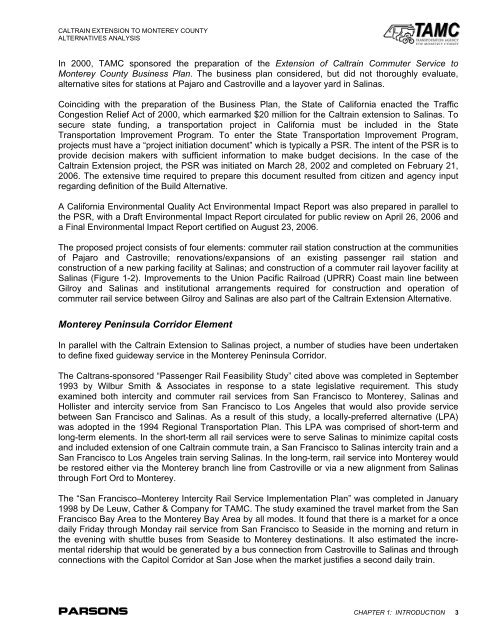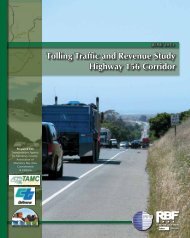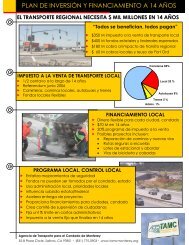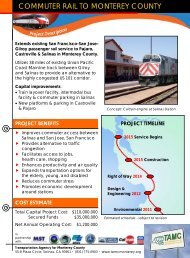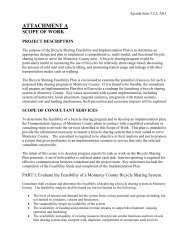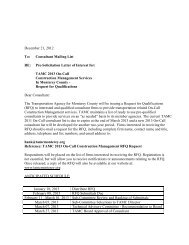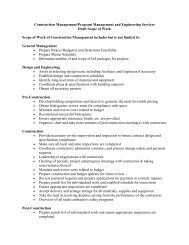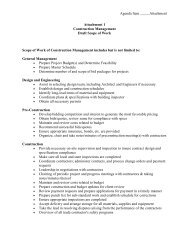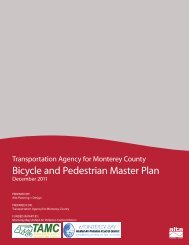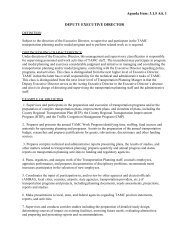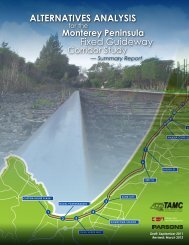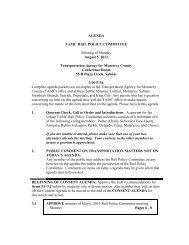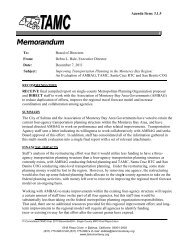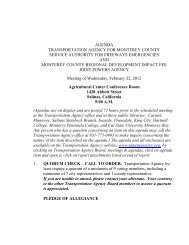Commuter Rail Extension Alternatives Analysis - Transportation ...
Commuter Rail Extension Alternatives Analysis - Transportation ...
Commuter Rail Extension Alternatives Analysis - Transportation ...
Create successful ePaper yourself
Turn your PDF publications into a flip-book with our unique Google optimized e-Paper software.
CALTRAIN EXTENSION TO MONTEREY COUNTYALTERNATIVES ANALYSISIn 2000, TAMC sponsored the preparation of the <strong>Extension</strong> of Caltrain <strong>Commuter</strong> Service toMonterey County Business Plan. The business plan considered, but did not thoroughly evaluate,alternative sites for stations at Pajaro and Castroville and a layover yard in Salinas.Coinciding with the preparation of the Business Plan, the State of California enacted the TrafficCongestion Relief Act of 2000, which earmarked $20 million for the Caltrain extension to Salinas. Tosecure state funding, a transportation project in California must be included in the State<strong>Transportation</strong> Improvement Program. To enter the State <strong>Transportation</strong> Improvement Program,projects must have a “project initiation document” which is typically a PSR. The intent of the PSR is toprovide decision makers with sufficient information to make budget decisions. In the case of theCaltrain <strong>Extension</strong> project, the PSR was initiated on March 28, 2002 and completed on February 21,2006. The extensive time required to prepare this document resulted from citizen and agency inputregarding definition of the Build Alternative.A California Environmental Quality Act Environmental Impact Report was also prepared in parallel tothe PSR, with a Draft Environmental Impact Report circulated for public review on April 26, 2006 anda Final Environmental Impact Report certified on August 23, 2006.The proposed project consists of four elements: commuter rail station construction at the communitiesof Pajaro and Castroville; renovations/expansions of an existing passenger rail station andconstruction of a new parking facility at Salinas; and construction of a commuter rail layover facility atSalinas (Figure 1-2). Improvements to the Union Pacific <strong>Rail</strong>road (UPRR) Coast main line betweenGilroy and Salinas and institutional arrangements required for construction and operation ofcommuter rail service between Gilroy and Salinas are also part of the Caltrain <strong>Extension</strong> Alternative.Monterey Peninsula Corridor ElementIn parallel with the Caltrain <strong>Extension</strong> to Salinas project, a number of studies have been undertakento define fixed guideway service in the Monterey Peninsula Corridor.The Caltrans-sponsored “Passenger <strong>Rail</strong> Feasibility Study” cited above was completed in September1993 by Wilbur Smith & Associates in response to a state legislative requirement. This studyexamined both intercity and commuter rail services from San Francisco to Monterey, Salinas andHollister and intercity service from San Francisco to Los Angeles that would also provide servicebetween San Francisco and Salinas. As a result of this study, a locally-preferred alternative (LPA)was adopted in the 1994 Regional <strong>Transportation</strong> Plan. This LPA was comprised of short-term andlong-term elements. In the short-term all rail services were to serve Salinas to minimize capital costsand included extension of one Caltrain commute train, a San Francisco to Salinas intercity train and aSan Francisco to Los Angeles train serving Salinas. In the long-term, rail service into Monterey wouldbe restored either via the Monterey branch line from Castroville or via a new alignment from Salinasthrough Fort Ord to Monterey.The “San Francisco–Monterey Intercity <strong>Rail</strong> Service Implementation Plan” was completed in January1998 by De Leuw, Cather & Company for TAMC. The study examined the travel market from the SanFrancisco Bay Area to the Monterey Bay Area by all modes. It found that there is a market for a oncedaily Friday through Monday rail service from San Francisco to Seaside in the morning and return inthe evening with shuttle buses from Seaside to Monterey destinations. It also estimated the incrementalridership that would be generated by a bus connection from Castroville to Salinas and throughconnections with the Capitol Corridor at San Jose when the market justifies a second daily train.parsons CHAPTER 1: INTRODUCTION 3


